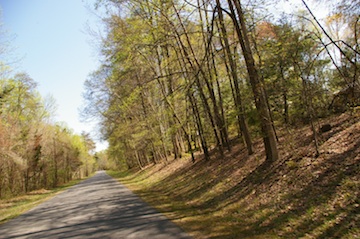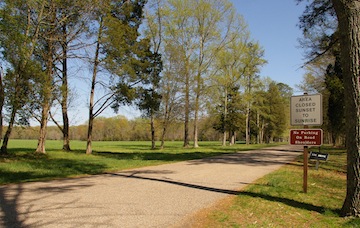Is It Just a Road?
 Lee Drive, on the Fredericksburg Battlefield, always has more foot traffic using it than cars. Or so it seems.
Lee Drive, on the Fredericksburg Battlefield, always has more foot traffic using it than cars. Or so it seems.
On an average day, when the weather is clear and the temperature is above 40 degrees, the main road accessing the southern portion of the battlefield sees a lot of use by locals: runners with iPods around their forearms; cyclists in their spandex pants speeding down the road; walkers leisurely following their dogs along the earthworks. I cannot remember a time when the sun was out and there wasn’t anyone out and about along this historic piece of ground.
But that isn’t why this road was created.
Among the historians here, this road has been a point of contention. We recognize that it’s used more by the locals for recreation purposes than by our visitors for educational purposes. Its long, hardly interrupted corridor lined with forest vegetation makes it a safe and encouraging location to stretch those desk-tired muscles.
Due to the nature of my job, I, too, am on the road every day—not to mention the fact that I live along the road, too. So, I’ve become familiar with the gentleman who walks his Great Danes every afternoon around two o’clock. Or the woman with the long braid who won’t say “no” to the rain that tries to stop her from running.
Parking lots are consistently full, but not with cars tagged from Kentucky, Idaho, or California. No, they’re all from Virginia. They are here to enjoy the outdoors.
 One hundred and forty-nine years ago this week, the men along the line here weren’t enjoying themselves too much, though. Confederate soldiers under the leadership of Gen. “Stonewall” Jackson lined this piece of high ground in anticipation of a Union attack. After the 13th, the ground was also occupied by the dying corpses of Union soldiers after their unsuccessful attack.
One hundred and forty-nine years ago this week, the men along the line here weren’t enjoying themselves too much, though. Confederate soldiers under the leadership of Gen. “Stonewall” Jackson lined this piece of high ground in anticipation of a Union attack. After the 13th, the ground was also occupied by the dying corpses of Union soldiers after their unsuccessful attack.
This failure of Union troops to push completely through the Confederate line ended in what is now known as “Lee’s Most Decisive Victory.” For General Burnside, it was arguably his most embarrassing moment in the war.
Today, visitors can view refurbished earthworks lining the road, they can walk up to the knoll that General Lee claimed as his headquarters, and they can stroll along the forsaken lunettes, or cannon pits, located at Prospect Hill.
They will most assuredly encounter many locals, too: joggers, cyclists, dog-walkers, people out for a leisurely stroll in an uninterrupted green space.
Don’t get me wrong. By no means am I perturbed by the high recreational use of the road by many locals. On any other day, on any day that wasn’t December 13th, I would encourage cyclists and runners to explore this historic land, its road and its trails.
But after how many jogs, rides, or strolls does a road become simply…a road?
Yesterday was the 149th anniversary of the brutal attacks against this position. Approximately 9,000 soldiers were killed, went missing, or became seriously wounded. Nine thousand souls—gone.
As I drove along the Lee Drive for routine work, I couldn’t help but wonder if the same people I see almost every day were aware of this. Did they realize that, during the time they were squeezing in their daily 30-minute workout, lives had been forever changed years prior? Did they realize that, had it not been for the sacrifice given in one of the most tumultuous times in our nation’s history, there would not be a nice, recently paved, safe road to exercise on—let alone many other things?
And yet what makes yesterday’s date so different from, say, today? Or next week? Shouldn’t we be in remembrance every day we drive on this sacred tract of land? I say “yes,” but I believe anniversaries will never stop holding powerful clout as we remember certain occasions.
I don’t think this park will ever ban the recreational use of its roads, nor should it. But I do hope that its users take a little extra time to exercise their minds with the knowledge that this is sacred ground, that the asphalt-covered road is, indeed, not just a road. It is a pathway that takes us back to a defining moment in our heritage. It is a pathway that reminds us of where we’ve been and where we should never go again.
I am now reading “Fredericksburg! Fredericksburg!” by George Rable. Can you please tell me if Lee Drive corresponds to one of the battlefield roads? Since you pinpoint it as at the southern part of the battlefield where Jackson was deployed, might it be the “Military Road,” or perhaps the “Richmond Stage Road,” or the road at Hamilton’s Crossing? I have not yet visited the Fredericksburg Battlefield so do not know what portion of the battlefield is preserved today. Hope to get there soon! Thank you.
Amanda, you’ve chosen a great book to read on the Battle of Fredericksburg. The Lee Drive that is mentioned in this essay is actually not a wartime road. It was constructed during the creation of the park in the 1920’s to follow what once was the Confederate line in 1862. If you look at historic maps, you should be able to notice a continuous line of Confederate troops that parallel both the Richmond, Fredericksburg, and Potomac RR (RF&P) as well as the Richmond Stage Road (modern day Rt.2 and 17). If you have any questions about the boundaries the park owns today, feel free to contact us here at EMC. Enjoy the rest of your read!
Thank you! I am looking now at Civil War Trust maps to follow your directions, and resolve more than ever to visit that battlefield. This summer, for sure!
Well said…..We drove down that road many times when we were there volunteering and I had some of the same thoughts that you do. Thank goodness there is still a reminder of what happened there many years ago.
Enjoyed the pictures too.
Thanks for your thoughts and for your time here at the park!
Your insight is a truism for the entire town. As I am employed at, and attend, one of the old downtown churches, I often find my mind wandering while in the old 1855 sanctuary (no reflection on the minister’s sermon!). I watch the people who have come to worship a God of love, grace, and mercy and ponder that most have never given any thought that the very spot in which they are comfortably seated was once occupied by wounded, and possibly dying, Union soldiers. The blood stains are washed away and the damage repaired – there is nothing to remind them that that sanctuary has been hallowed, not only because it is a house of God, but also because of the sacrifice of men.
There are important lessons to be learned from Lee Drive, from my church, and dozens of other sites around here. I hope the stories will never be lost.
Well said, Dennis. I guess it is one of the difficulties of living in a historic environment. When is this space simply a space to live in? Should we always be remembering the events that took place here? Is there ever any balance? I am sure we are not the only historic site and historic town that deals with these issues. It is always good to be reminded, however, that these events should never be forgotten.
I believe that people do think of it more than we imagine–some more than others. Those of us who are attuned to history hold the traumatic events that real people lived through ever on our minds and hearts. Others may be more focused on the present; nevertheless, I think they cannot help but feel the immensity of what happened on that very ground. They might not express it, and abstain from delving into the details as we do. But it is there, and we are all undeniably connected with the generations who have preceded us.
For example, this past summer I was at the Manassas Battlefield walking some of the high and low ground in the vicinity of Hood’s attack on Warren’s New York brigade, leading up to Chinn Hill and the momentous fighting that occurred there. I was delighted to look up and see horseback riders weaving their way along the trails. Those animals connected me to the many equine participants of the battle I was studying, which happened to be Second Manassas on that particular day. The horsewomen stopped and conversed with me; they noted my maps and seemed to acknowledge my endeavor. I expressed my admiration of the horses and they in turn shared their praises of the Park Service and its trail maintenance. But something wordless and significant passed among us: a reverence for that moment, for the very earth upon which we conversed. They do sense it! The joggers, even plugged into their iPods, the walkers, the recreational visitors–their very bodies take it in even if their conscious minds do not.
Great input, Amanda. Who is to say that others on these sacred fields look at us and think the same thoughts? It is difficult to fully understand the level of reverence with which people hold when utilizing these spaces. Hopefully we are able to maintain these resources for people to visit (and enjoy!) for years to come.
I grew up in Fredericksburg and was stationed at the Pentagon a few years ago, allowing me to live there again. I took the opportunity to explore the battlefield, and the battle sites in the city, through running. Not everywhere is so friendly (River Road on the north side of the Rappahannock can be dicey). Winter is best as it is the season of the battle and the lack of leaves means you can see farther. Lee Drive is a great long run. It’s good to approach from various angles, especially coming up Lansdowne Road to get a sense of the distance the Union troops had to cover from the river. While running isn’t perfect, I think that with some knowledge of an engagement, moving almost wholly on foot gives a better idea of the time-space and fatigue challenges of Civil War battle.
Phil, thanks for your thoughts. You say that running isn’t perfect. No, perhaps it isn’t. However, it is probably a lot better than going by car to get, as you say, a sense of the effort put forth by the soldiers. Normally, the soldiers would not be moving at the speed you might be when you run. However, it would not have been uncommon for them to have carried up to 50 pounds of supplies. I would bet carrying that load could be similar (but not equal) to the exertion created when running. If you should have any more reflections on more runs you do on any CW battlefield, feel free to share it with us…we’d love to hear!
I love that trip down Lee Drive, particularly in the summer when the whole stretch is lush and alive with color. Not at all what it looked like at the time of the battle, of course, but it’s still a worthwhile place to escape and reflect.
Thanks for taking the time to take me back down the road.